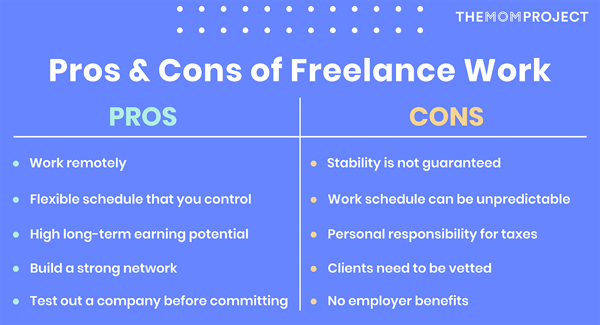Freelance is an umbrella term for several different types of employment statuses. According to a 2019 research study by Upwork and Freelancers Union, the term Freelance includes independent contractors, temporary workers, self-employed, diversified workers and moonlighters. Each of these employment statuses varies in one way or another, but the one thing they have in common is that, in some capacity, they work for themselves.
Freelancing is becoming more and more popular, with freelancers making up 35% of the workforce in 2019 and freelance job postings rising 41% in the second half of 2020 (due largely in part to the coronavirus pandemic). For workers, freelancing provides a lot of flexibility and control over their working hours, and for companies, it typically saves them a bit of money.
There are a lot of reasons someone may want to go into freelancing. It could be a side job to earn extra money for something special like a vacation, an opportunity to get more experience in a new field, or to reduce stress and gain more autonomy in their professional life. The flexibility freelancing offers is also a major driving factor, especially for parents and caregivers, which make up 46% of all full-time freelancers.
Shifting from a traditional job into a freelancing role can be very appealing, but it’s not something you can do successfully overnight. As much as you’d probably love to wake up tomorrow and be your own boss, it’s not that simple. It takes time to build the skills, experience and network to transition into full-time (or part-time) freelance work. While freelancing can be a lucrative and rewarding job path for some personalities, others may find it more stressful than working a traditional job.
So, before you take a deep dive into freelance work, start with the basics to determine if it’s a direction you want to go in.

Freelance 101
What is freelance work?
The ‘Freelancing in America’ study breaks freelance work down into five segments:
- Independent contractors make up 33% of freelancers, they don’t have an employer and “work on a project-to-project basis” either full-time or part-time.
- Temporary workers make up 6.4% of freelancers and they work short-term jobs for employers, typically with an established end-date.
- Moonlighters have traditional full-time jobs and do freelance work on the side, and they make up 26% of freelancers.
- Freelance business owners account for 5% of freelancers, they are contract workers with a team that they employ to help them complete projects.
Finally, diversified workers make up 30% of the freelance workforce, and they bring in income through several sources, including traditional and freelance jobs.
Who benefits the most from freelance?
Companies and workers both benefit from freelance work. Employers can expect to save 20-30% on a freelance employee because they’re not providing benefits. Freelancers benefit by setting their own rates (often higher than what they would get in a traditional role) and having control over the projects they take on, their workload and schedule.
What does freelance job availability look like?
The number of freelance opportunities varies significantly by industry, with creative jobs in art and entertainment having the most opportunities. Around 40-50% of construction, engineering and technology jobs are made up of freelance workers, while other industries like education, finance, retail, healthcare and manufacturing have more traditional employment opportunities than freelance.
Pros & cons of freelance work
Pros of freelance work:
- Work a flexible schedule that you control
- Work remotely - 75% of freelancers work from anywhere
- Build a strong network
- Test out a company before committing to a full-time job
- High long-term earning potential
Cons of freelance work:
- Work schedule can be unpredictable
- Stability is not guaranteed
- No employer benefits like health insurance or 401k options
- Need to vet clients to ensure payment reliability
- Personal responsibility for federal and state income, social security and Medicare tax withholding

Pivoting from permanent to freelance work
Who will thrive in freelancing?
Here’s the hard truth: you have to be very motivated to succeed as a freelancer, especially a full-time freelancer. Since work is not guaranteed and can be short-term, it requires a lot of networking to always have something in the pipeline for when a project ends (whether expected or unexpected). Freelancers also often have to juggle multiple projects at once, managing several deadlines simultaneously. It requires a lot of scheduling, organization and drive. Someone looking for a job they can sign off from at the end of the day and not think about it again until the following morning likely won’t enjoy full-time freelancing.
On the other hand, someone who is deadline-driven, prefers job autonomy and has a large professional network (or the motivation to build one) might do really well as a freelancer. Someone who is self-aware and knows their professional limits will also do well because they will likely under-promise and over-deliver to their clients, which ultimately builds long-term relationships. You can’t phone it in as a freelancer, but if you’re motivated and organized, you’ll do well.
What should be considered before transitioning to freelance work?
Freelance work isn’t stable, so if you’re transitioning to full-time freelance work, you’ll want to ensure you have a financial cushion in case anything unexpected arises. Also, consider how you will get health insurance since it won’t be provided by your employer. If you plan to take an extended leave, you will want to negotiate that into your contract because you likely aren’t covered by any job protections.
What are red flags to look out for?
Whether you’re dipping your toes into freelancing or you’re diving into it full-time, you want to ensure you are working with reputable, reliable clients. A good client is organized, treats you well, pays you fairly and pays on time. Typically, these clients offer you some kind of contract that lists out essential job duties, payment terms (including rate, frequency and method), project length and any other details you negotiated with them prior to drafting the contract. If a client doesn’t offer you a contract, that’s a red flag. If this happens, do a deep dive into their company and try to find reviews from clients and employees to determine legitimacy.
Finances of freelancing
What are the costs of freelancing?
In a traditional job, you’re often provided with a desk, chair, computer and other essential equipment (or at least a stipend for them). However, when you’re working for yourself, those costs are on you. Think about all the things you’ll need to do your job. Will you be putting a lot of miles on your car, costing you money in fuel and maintenance? Do you need to have your phone on you at all times? Is your internet speed enough or do you need to improve it? Do you need to rent out a co-working office space? Even as a freelancer, there are overhead costs.
One thing to keep in mind when assessing these costs, though, is that many of them can be written off when filing taxes at the end of the year. However, unless you’re one yourself, you’ll likely need to pay an accountant to help you file your yearly taxes to make sure everything is correct, so that’s another possible added expense.
How are payment rates assessed and set?
To properly set your rate, you’ll need to do a few things. First, determine the average full-time salary of someone with your experience doing the same job as you in a traditional workplace (look at the average in the US as a whole if you plan to work with clients in different states).
Once you have that salary, add the yearly cost of health insurance and overhead to it. Take that number and divide it by 2080, the average number of hours worked in a year by a full-time employee. This will give you a general idea of how much to charge an hour (or projects based on estimated hours spent).
👉 Take a look at freelance opportunities posted on career search sites like The Mom Project and compare your rate to fellow-freelancers’ to make sure you’re not charging significantly more or less than others with your level of expertise and standard rates within your industry.
Is it possible to make a living salary freelancing?
In 2019, freelancers’ income contributed $1Trillion into the economy and made up 5% of the GDP. A decade ago, freelancing was looked at as a short-term moneymaker for someone in between jobs, but now, 50% of full-time freelancers see it as a long-term solution and 93% feel confident knowing they can always work more if they need more money.
All that’s to say, yes, you can make a living salary as a freelancer. However, keep in mind that it will likely take a while before you get to that point. You’ll need to do some research, freelance on the side, build a work portfolio, network and build on your skills before you’re in a place to make the jump to full-time freelancing.
Freelancing and career potential
Freelancing is an excellent way to further your career or change the direction of it completely. If you’re in an administrative job, you can build your creative skills through freelancing on the side and eventually gain enough experience to transition into that industry. Even freelancing in something you’re already doing will help strengthen your skills and make you more marketable as an employee, whether in a traditional setting or otherwise.
As far as career satisfaction, if you make the move to full-time freelancing, you may find that you don’t want to go back. When surveyed, 51% of full-time freelancers said there was no amount of money a company could offer them that would convince them to go back to a traditional role.
Freelance work isn’t for everyone, and that’s okay. If you’re considering it, though, having a solid understanding of the basics will help you avoid surprises and frustration as you get started.
Find your fit with The Mom Project
Join The Mom Project to create your talent profile and browse permanent, freelance and contract career opportunities from vetted companies that support work and life integration. 



